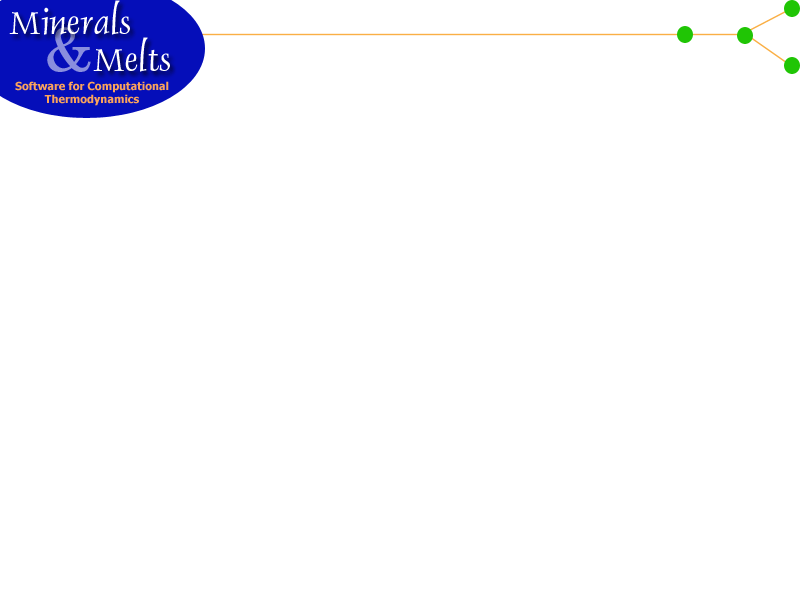Using MELTS to calculate a Crystallization Model with one or more Solid Phases suppressed
This example demonstrates how to suppress crystallization of one or more solid phases during a MELTS calculation. We will determine the saturation state of water in a (possibly metastable) liquid of olivine tholeiite bulk composition.- Start MELTS:
- Type the composition of the following olivine tholeiite (+ excess water) into the text entry fields of the liquid composition panel.
SiO2 48.21 TiO2 1.70 Al2O3 15.23 FeO(T) 10.00 MgO 8.72 CaO 11.51 Na2O 2.29 K2O 0.20 H2O 8.00
This is done by clicking in the white box to the right of SiO2 (use the left mouse button to select the box) and typing the weight % value:. The delete key, arrow keys and mouse may be used to edit the ty ped value.
Typing a return advances the text entry cursor to the next oxide. Continue entering the composition until the liquid composition display panel looks like:
The water content in the above is purposely input as larger than the expected saturation value. We will determine the saturation condition by (1) specifying T and P, (2) supressing crystallization of the solid phases and (3) exolving water as a separate phase until the system comes to equilibrium.
- Now that the composition has been entered, the temperature and pressure constraints must be specified. Using the mouse, pop down the intensive variables menu and release the mouse button of the T,P... menu entry. Fill in the white text entry panels of the T,P,... dialog box to look like this:
The starting and stopping temperatures are both set to the temperature at which we want to determine the water saturation state. The temperature increment is zero (as the temperature will not change in this model) and may be left blank. The starting and stopping pressures are set equal to the system pressure. The pressure increment and dP/dT gradient are zero and may be left blank.
- Before the saturation state of water may be calculated, the ferric/ferrous ratio must be specified. Because only the total FeO was given as input, this requires a model assumption regarding the oxidation state of the magma.
To impose an oxygen fugacity equivalent to the Quartz-Fayalite-Magnetite buffer at the starting temperature and pressure, select the f O2 Constraint entry of the Intensive Variables menu and while depressing the left mouse button, slide the mouse to the right and down and release on the Q-Fa-Mt constraint buffer entry.
Next, go to the Composition menu and select the Compute Redox State entry. The Fe2O3 and FeO quantities displayed in the liquid composition panel should change to reflect a ferric/ferrous ratio appropriate to the QFM buffer for a hypothetical liquid of the bulk composition displayed at the starting T and P entered above.
Finally, turn off the f O2 constraint by selecting the absent option item of the f O2 Constraint entry of the Intensive Variables menu.
- Now we specify which solid phases to prevent from crystallizing. Go to the Options menu and select the Solid Phases... entry. A dialog box like the following should appear:
By default all solid phases are allowed to crystallize. This is indicated by a filled or highlighted diamond symbol to the left of the indicated phase. Supressed phases are labeled by an unfilled diamond. (Phases to be made available in a later MELTS release are inactive and toggled permanently off.) Turn off all of the solid phases by clicking on the diamond symbol or the phase name using the mouse pointer and the left mouse button. Leave wat er checked on.
- At this stage the initial conditions and reaction path constraints have been specified. The model is initiated by invoking the Exceute/Halt entry of the Commands menu.
Modeling results are output to the display and to a number of disk files. For information on display elements (including graphs) consult the manual page.
The model may be halted at any time by invoking the Execute/Halt entry of the Commands menu. The user may change bulk composition or model constraints and restart the calculation using the same menu entry.
A manual page describes many common numerical problems that may occur when the program is running.
- The results of this simple model are displayed in the liquid composition panel. In this case the panel looks like:
MELTS has determined that at 1200 C and 500 bars, the saturation state of water is 1.81 wt % in the liquid. The remaining water in the system should be listed as a separate phase in the phase display panel.
- Exit the program by invoking the Exit entry of the Commands menu.
